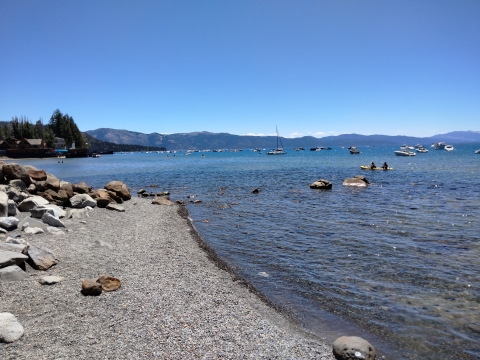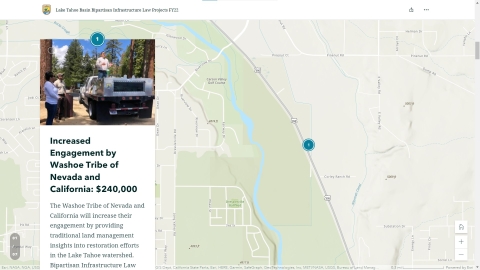What We Do
Our Laws and Regulations
A $17 million investment in wildlife, and a renewed commitment to Tribal engagement.
The Bipartisan Infrastructure Law Bipartisan Infrastructure Law
The Bipartisan Infrastructure Law (BIL) is a once-in-a-generation investment in the nation’s infrastructure and economic competitiveness. We were directly appropriated $455 million over five years in BIL funds for programs related to the President’s America the Beautiful initiative.
Learn more about Bipartisan Infrastructure Law was signed in November 2021 and made a historic $17 million investment in the Lake Tahoe Basin. A total of $3.4 million in year one investments from FY22, $3.4 million in year two investments from FY23, $3.4 million in year three investments in FY24, and $3.1 million in year four investments in FY25 will support proven projects and expand collaborative efforts in Lake Tahoe.
Located on Washoe ancestral lands, Lake Tahoe holds significant cultural importance for The Washoe Tribe of Nevada and California and is part of the historic range of Lahontan cutthroat trout. To oversee restoration efforts in the Lake Tahoe watershed, the Washoe Environmental Protection Department was established in 1998 and has been a key partner in ongoing restoration work.
The Lake Tahoe Basin faces ongoing threats from the introduction and spread of aquatic invasive species invasive species
An invasive species is any plant or animal that has spread or been introduced into a new area where they are, or could, cause harm to the environment, economy, or human, animal, or plant health. Their unwelcome presence can destroy ecosystems and cost millions of dollars.
Learn more about invasive species . Common invasive weeds, like the Eurasian watermilfoil, can significantly disrupt aquatic ecosystems and crowd out native species. Aquatic invasive species management is a top priority of the Lake Tahoe Environmental Improvement Program, one of the most comprehensive restoration programs in the nation.
For more information about projects that have received Bipartisan Infrastructure Law funding in Lake Tahoe, explore the StoryMap.
Lake Tahoe Basin projects with funding from Bipartisan Infrastructure Law
Project Name | FY22 Funding | FY23 Funding | FY24 Funding | FY25 Funding |
|---|---|---|---|---|
Washoe Tribe PrioritiesFor Washoe Environmental Protection Department (WEPD) staff to fully engage on planning, monitoring and control of AIS from a Washoe Tribe perspective. For WEPD staff to build more effective working relationships with environmental partners working in Lake Tahoe and to contribute early and often to prioritization of projects (including AIS) in the Environmental Improvement Program, especially, along streams named as Washoe priority in the Lake Tahoe Watershed Assessment. For WEPD staff to contribute to removal of nonnative fish species (AIS as well) and to monitor and advance the recovery of native fish species, especially, Lahontan cutthroat trout and whitefish. For WEPD to successfully complete the Máyala Wáta Restoration Project along Meeks Creek and adjacent wet meadows including Lahontan cutthroat trout accessing stream while controlling AIS found in Meeks Bay. | $681,724 | $392,779 | $370,380 | $370,380 |
Bilingual AIS Education and OutreachThe resident and visitor population of Lake Tahoe is diverse and includes a significant number of people who are part of the Latinx community. Public education is critical when it comes to preventing the introduction of AIS into the region, but many educational materials are not currently available in Spanish. This investment will fund rack cards, educational kiosks, billboards, public service announcements, trainings, and other educational materials to be disseminated throughout northern California and Nevada in both Spanish and English. | $64,635 | $100,000 | ||
Permanent Watercraft Inspection StationsThe Lake Tahoe Watercraft Inspection Program is one of the most successful programs in the country, with no new invasions discovered since program inception in 2008. Currently, inspections occur at three off-ramp, temporary inspection stations along corridors into the Region during the summer months. This investment will fund two new permanent inspection stations to ensure efficient long-term inspections. | $500,000 | $2,495,880 | $2,216,744 | $2,716,744 |
Taylor-Tallac AIS Control ProjectThe Taylor and Tallac creeks and marshes are infested with approximately 17 acres of the invasive aquatic weed Eurasian watermilfoil. This investment will fund the installation of benthic barriers that smother invasive aquatic plants and prevent photosynthesis by blocking sunlight. *In FY23, $206,229 Bipartisan Infrastructure Law Lake Tahoe Marina Redesign Feasibility Study funding was reallocated to the Taylor-Tallace AIS Control Project. | $1,550,000 | *$206,229 | $500,000 | |
Lake Tahoe Marina Redesign Feasibility Study*Most AIS infestations occur within and around the marinas on Lake Tahoe. This investment will fund a feasibility study to determine the potential for redesign at marinas around the lake to help reduce potential AIS infestation. | - | N/A | ||
Meeks Resort Non-motorized PreventionTRPA staff have identified a tool that will aid non-motorized AIS prevention efforts by providing a location recreationists can make their craft clean, drain, and dry. This project would be a collaborative effort with The Washoe Tribe of Nevada and California at the Meeks Bay Resort where TRPA staff would acquire the equipment and train staff, and Tribal staff would direct recreationists to use the tool and provide outreach, and the minor maintenance needed. | N/A | $120,864 |
Additionally, the Service used $397,412 in FY22 and $290,477 in FY23 to build capacity, hold staff trainings and deliver services.


